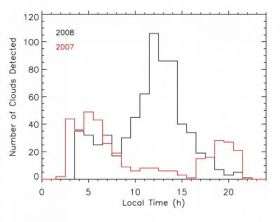SHIMMER successfully observes Earth's highest clouds

The Naval Research Laboratory's Spatial Heterodyne Imager for Mesospheric Radicals (SHIMMER) has successfully observed a second northern season of Polar Mesospheric Clouds (PMCs), which are the Earth's highest clouds. This successful observation fulfills the primary goal of the Space Test Program Satellite-1 (STPSat-1) Extended Mission.
SHIMMER was originally launched as the primary payload of STPSat-1 on March 8, 2007, with the objective to demonstrate the novel optical technique of Spatial Heterodyne Spectroscopy and to obtain global measurements of the hydroxyl (OH) radical in the Earth's mesosphere (50-90 km altitude). After the successful completion of its nominal 1-year mission, STPSat-1 operations were transitioned to NRL, which has been operating the spacecraft since June 1, 2008 using a novel, low cost operations approach.
The primary objective of the SHIMMER Extended Mission was to continue global scale PMC observations during the northern PMC season, which ended in August 2008. PMCs form in a thin layer in summer near 82 km over polar latitudes. Some have argued that, due to increases in atmospheric humidity, cloud occurrences have been increasing in recent decades. Because STPSat-1 is in a relatively low inclination orbit, SHIMMER observes PMCs at their equator-ward edge (<58°), but more importantly, makes measurements at a wide range of local times. This ability for SHIMMER to make measurements of the variation of PMCs throughout the day is unique among the several satellites that have observed PMCs, explains Dr. Christoph R. Englert, principal investigator of SHIMMER.
SHIMMER has now measured the PMC diurnal variation for the two northern seasons of 2007 and 2008, and surprisingly, the variation is quite different. Even though a semidiurnal signature, that is two peaks per day -- one in early morning and one in the late afternoon -- was observed in 2007; in 2008, the variation was diurnal or one peak per day (see figure). This result has important implications for the inference of long-term trends from historical, space-based PMC observations because NASA and NOAA satellites that have observed PMCs over the last 25 years have all been launched into sun-synchronous orbits with different, fixed local times. Until the diurnal variation of these clouds is better understood, the SHIMMER data show that it is premature to make firm conclusions about multi-decadal trends in PMCs.
Source: Naval Research Laboratory




















